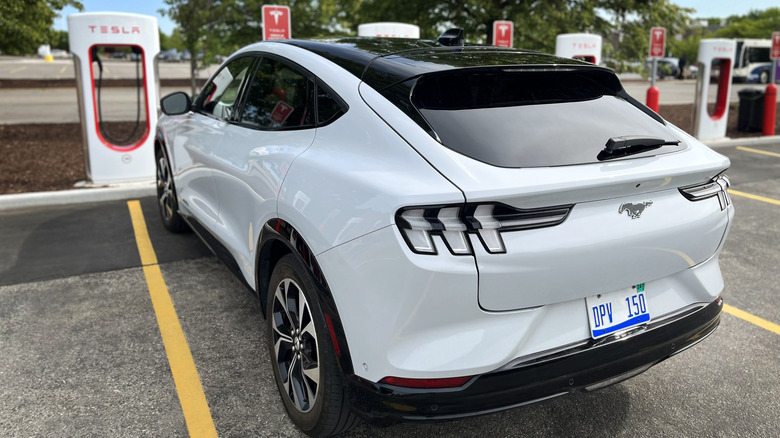What Is The North American Charging Standard, And Did Tesla Invent It?
As Tesla continues to expand the range of manufacturers that can access its Supercharging Network, you may be wondering what the differences are and what potential barriers may be in the way if you intend to fill your battery at one of the red and white recharge points. The most obvious barrier is access: Unless you're driving a Tesla, or from next year a Ford, you'll only be able to access the Supercharging Network in a few limited areas.
Even if your vehicle has access, there are still barriers in the way. The most likely hurdle relates to the charging port built into your car. Teslas use a charging port known as the "North American Charging Standard" (NACS), while most other manufacturers opt for the Combined Charging System (CCS) instead.
If your car has a different port to your preferred charger, it isn't the end of the world. Adaptors are available that can allow NACS vehicles to use CCS chargers and vice-versa. But what is NACS? Who invented it? What impact will it have on EV use and design going forwards?
What is the North American Charging Standard?
Despite being named the "North American Charging Standard," NACS is far from the most common port in North America. As things stand, only Tesla really uses it. Musk's company invented the charger for use in its vehicles, and true to form, claims it is both significantly smaller and more powerful than the CCS system almost all other North American EV uses.
If you're using a Tesla Supercharger in the U.S., Mexico, or Canada, you'll either need a car with a NACS charging port, or an adapter. If you're using a charging station outside of Tesla's network, it's likely to be using CCS.
However, Tesla seems to have a significant interest in its system becoming the most popular option, and decided to make it "open source" late last year. Now, other manufacturers have access to the design and can fit it to their vehicles for free. Ford has already offered to fit NACS ports to its next generation of electric vehicles. So while the system's name seems a bit presumptuous, there's a decent chance it will be quite fitting in a few years' time.
Will it actually become the standard?
While NACS currently isn't the standard, it could take that title at some point in the future. Access to Tesla's supercharging network is a barrier, and non-Tesla EV owners probably won't want a vehicle if they have to use an adapter every single time they charge it.
However, that is a barrier Tesla is working on expanding access over the next few years. Tesla isn't the only one pushing NACS, as EV company Aptera has gone as far as to petition Congress to make NACS the official EV charging standard in the United States.
Switching to Tesla's standard may also be better for the EV industry on the whole. One of the biggest barriers to electric vehicle adoption is a lack of charging infrastructure. According to documents filed in Texas, a Tesla charging station can cost as little as a fifth of what some alternatives cost. Cheaper stations make building more of those stations practical. More charging stations, in turn, make an EV a more enticing prospect for many drivers.
The fact that only Tesla is really using this port en masse is mitigated by the company's utter domination of the EV market. In the third quarter of last year, close to half of all EVs sold in the U.S. were built by the Texas-based automotive company. While CCS is likely to be around for a while, it may be hard to bet against Tesla for EV charging.


